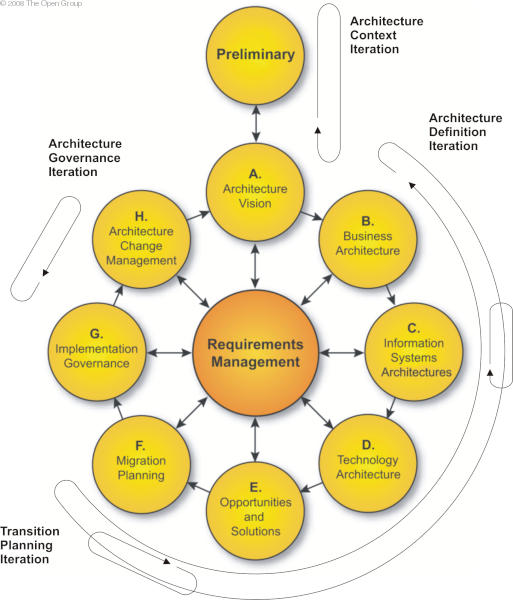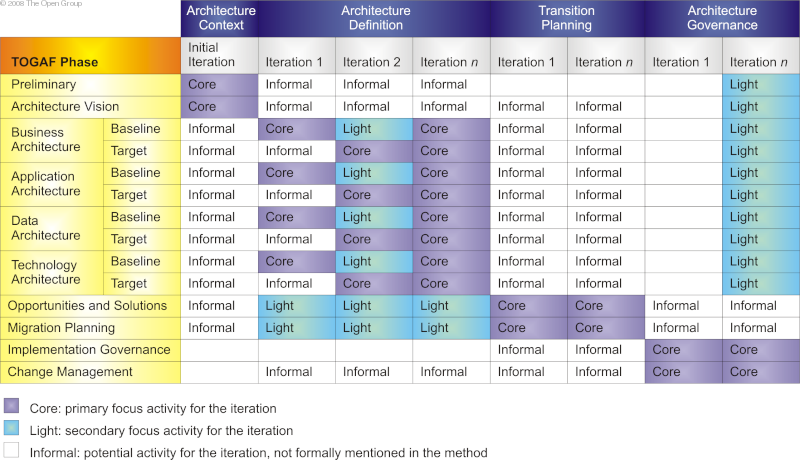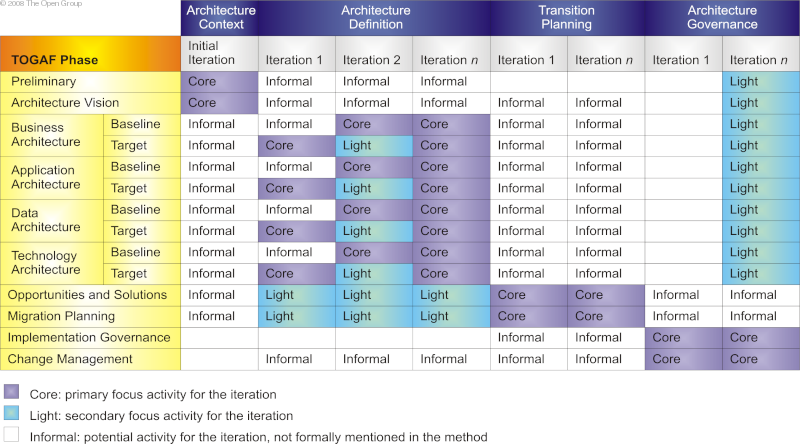
| You are here: | ||
| <<< Previous | Home | Next >>> |
The Architecture Development Method (ADM) is a flexible process that can be used to support the development of architecture as a stand-alone process, or as an extension to other solution development or project management methods.
Many organizational factors will influence the extent to which the ADM should be used in an iterative fashion. Particular factors for consideration would include:
The ADM supports a number of concepts that could be characterized as iteration. It is expected that:
All of these techniques are valid applications of the ADM and can be used to ensure that the approach to architecture development is sufficiently flexible to accommodate other methods and frameworks.
When considering planned iteration cycles that span a number of ADM phases, the following guidelines can be used to effectively group related architectural activities to achieve a specific purpose.
These ADM iteration cycles are intended to span multiple phases of activity and allow formal review upon completion of each multi-phase iteration cycle (for example, an Architecture Definition should be reviewed with visibility of the Business, Data, Application, and Technology Architectures, rather than in isolation).
The suggested iteration cycles are shown in Iteration Cycles .

Some iteration cycles can be executed once, whereas others have a natural minimum number of cycles. For some iteration cycles, each iteration follows the same process; where there is more than one iteration within a cycle, the process differs slightly for each of the iterations.
When considering the usage of iteration cycles, it is also necessary to consider where to place appropriate checkpoints within the process. If the expected level of stakeholder involvement is high, it may be sensible to carry out very frequent but informal checkpoints to ensure that the process is moving in the intended direction. If stakeholders are less closely involved, then checkpoints may be less frequent but more formal. Checkpoints at the completion of each iteration cycle, or at the end of several iteration cycles, are common.
Two process styles can be adopted within the ADM for the definition of architectures:
The rationale for these two styles is that, in many cases, consideration of the target is deferred until conclusions have been made on the baseline. Premature consideration in these situations may be disruptive or politically sensitive (because the Target Architecture influences organization, roles, and responsibilities). Equally, initiatives that are examining Target Architectures run the risk of being constrained by the baseline or appearing to be constrained by the baseline if significant time is spent examining existing solutions.
In practical terms, an architecture team will always give informal consideration to the baseline when analyzing the target (and vice versa). In situations where baseline and target are expected to be considered in parallel by stakeholders, it is recommended that the architecture team focuses priority on one state within the internal structure of that engagement in order to maintain focus and consistency of execution.
Each iteration cycle crosses multiple TOGAF ADM phases. The following tables show at a high level which phases should be completed for which iteration cycle, showing activity that is core (i.e., the primary focus of the iteration), activity that is light (i.e., the secondary focus of the iteration), and activity that may be informally conducted (i.e., some activity may be carried out, but it is not explicitly mentioned in the ADM).


|
Iteration Cycle |
Iteration |
Purpose |
Description |
|---|---|---|---|
|
Architecture Context |
Initial Iteration |
Establish the approach, principles, scope, and vision for the engagement. |
This iteration comprises a pass through the Preliminary and Architecture Vision phases of the ADM. |
|
Architecture Definition (Baseline First) |
Iteration 1 |
Define the Baseline Architecture. |
This iteration comprises a pass through the Business Architecture, Information Systems Architecture, and Technology Architecture phases of the ADM, focusing on definition of the baseline. Opportunities, solutions, and migration plans are also considered to drive out the focus for change and test feasibility. |
|
|
Iteration 2 |
Define the Target Architecture and gaps. |
This iteration comprises a pass through the Business Architecture, Information Systems Architecture, and Technology Architecture phases of the ADM, focusing on definition of the target and analyzing gaps against the baseline. Opportunities, solutions, and migration plans are also considered to test viability. |
|
|
Iteration n |
Refine baseline, target, and gaps. |
Subsequent Architecture Definitions attempt to correct and refine the target to achieve an outcome that is beneficial, feasible, and viable. |
|
Architecture Definition (Target First) |
Iteration 1 |
Define the Target Architecture. |
This iteration comprises a pass through the Business Architecture, Information Systems Architecture, and Technology Architecture phases of the ADM, focusing on definition of the target. Opportunities, solutions, and migration plans are also considered to drive out the focus for change and test feasibility. |
|
|
Iteration 2 |
Define the Baseline Architecture and gaps. |
This iteration comprises a pass through the Business Architecture, Information Systems Architecture, and Technology Architecture phases of the ADM, focusing on definition of the baseline and analyzing gaps against the target. Opportunities, solutions, and migration plans are also considered to test viability. |
|
|
Iteration n |
Refine baseline, target, and gaps. |
Subsequent Architecture Definitions attempt to correct and refine the target to achieve an outcome that is beneficial, feasible, and viable. |
|
Transition Planning |
Iteration 1 |
Define and agree a set of improvement opportunities, aligned against a provisional Transition Architecture. |
The initial iteration of transition planning seeks to gain buy-in to a portfolio of solution opportunities in the Opportunities & Solutions phase of ADM. This iteration also delivers a provisional Migration Plan. |
|
|
Iteration n |
Agree the Transition Architecture, refining the identified improvement opportunities to fit. |
Subsequent iterations of Transition Planning seek to refine the migration plan, feeding back issues into the Opportunities & Solutions phase for refinement. |
|
Architecture Governance |
Iteration 1 |
Mobilize architecture governance and change management processes. |
The initial Architecture Governance iteration establishes a process for governance of change and also puts in place the appropriate people, processes, and technology to support managed access to and change of the defined architecture. |
|
|
Iteration n |
Carry out architecture governance and change control. |
Subsequent iterations of the Architecture Governance cycle focus on period reviews of change initiatives to resolve issues and ensure compliance. |
The TOGAF document set is designed for use with frames. To navigate around the document:
Downloads of the TOGAF documentation, are available under license from the TOGAF information web site. The license is free to any organization wishing to use TOGAF entirely for internal purposes (for example, to develop an information system architecture for use within that organization). A book is also available (in hardcopy and pdf) from The Open Group Bookstore as document G091.